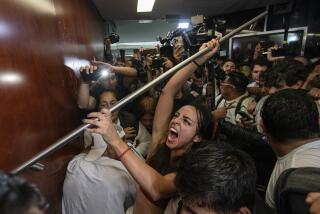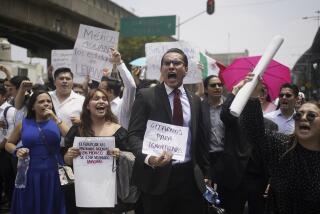Zedillo Government Thinks the People Protest Too Much
- Share via
MEXICO CITY — It was a television reporter’s worst nightmare: Eric Guerrero, the economic analyst for Mexico’s No. 2 station, was due on air. But there he was, trapped and fuming in his car, as protesters blocked the highway miles from the studio.
Thinking fast, Guerrero found a cameraman covering the demonstration for his station, TV Azteca. Standing amid honking traffic, he worked with him to broadcast the nightly business news--and added his own protest. Demonstrations in the nation’s capital, he told viewers, were causing $2.6 billion a year in economic losses.
“I demanded . . . that the federal government regulate these demonstrations,” he said Monday, recalling with some relish the incident a few weeks ago.
In this, one of the world’s largest cities, angry protests seem to be multiplying faster than public works projects before an election. This month alone, protesters have shut down the stock exchange, blocked major highways and even drawn their own blood in Mexico City’s main plaza, the Zocalo. How bad is it? In June, one group demonstrated against demonstrations.
“There are 12 to 15 protests a day,” declared Everardo Gamiz, head of the city council committee that handles citizen complaints. “Every day they get more aggressive.”
Now a group of Mexican politicians and business leaders has declared Basta! Gamiz’s party, the ruling Institutional Revolutionary Party, or PRI, has drafted a measure to regulate demonstrations. “Innocent bystanders should also feel they have the protection of the law,” he said in an interview.
For years, protests were a rare sight in Mexico--except for lock-step marches organized by the PRI. Under Mexico’s corporatist political system, citizens with complaints could turn to strong, relatively effective institutions, such as the ruling party or pro-government unions. Free-lance street protests were often suppressed.
But, analysts say, as Mexico’s authoritarian system has been weakened by free-market policies, economic crisis and political change, activists have turned to the only venue they see as effective: the streets. “This is a chaotic democracy, without institutions,” Lorenzo Meyer, a prominent historian, said of Mexico.
These days, the capital is regularly thronged with parents demanding school reforms, debtors looking for relief from banks and government workers pleading for more money. Marchers seek housing rights, union rights, human rights--often in the same protest.
The demonstrations have become an important way for Mexicans to let off steam peacefully. But, to many Mexicans, they create mounting confusion in an already chaotic city.
Last month, the chamber of commerce here issued a report complaining that downtown shopkeepers suffered an average 44.5% decline in their sales on the days when protests occurred. “There is an urgent necessity to pass a law about these demonstrations, marches and protests,” the report said.
A poll done by the city council indicated that 72% of Mexico City residents agreed. The PRI draft would forbid protesters to block highways, require that they register three weeks in advance and impose stiff penalties for wandering off the authorized route.
Some argue that these measures are a government effort to take back the streets. “This is what we call a fascist law, which would send Mexico back to the ‘50s and ‘60s,” said Dolores Padierna, an opposition city councilwoman.
Many demonstrators now flout the few legal requirements for public protests anyhow. But the government has been reluctant to crack down on them.
“The cost of repression [for the government] is very high,” Meyer said.
More to Read
Sign up for Essential California
The most important California stories and recommendations in your inbox every morning.
You may occasionally receive promotional content from the Los Angeles Times.













